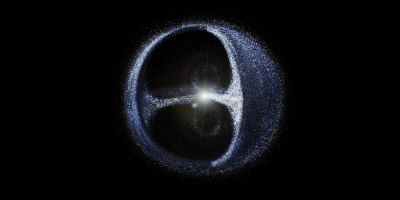Photo: Wikimedia (Pablo Carlos Bodassi)
A team of astronomers in Leiden has been able to calculate the first 100 million years of the history of the Oort cloud. So far, parts of history have been studied separately. The cloud, which contains about 100 billion comet-like objects, forms a massive crust at the edge of our solar system. Astronomers will soon publish their comprehensive simulations and their consequences in the Journal of Astronomy and Astrophysics.
The Oort cloud was invented by Dutch astronomer Jan Hendrik Oort in 1950 to explain why there are new comets with long orbits in our solar system. The cloud, which begins at more than 3,000 times the distance between the Earth and the Sun, should not be confused with the Kuiper Belt. This is the cutting edge of rock, gravel, and ice that contains the dwarf planet Pluto, which orbits relatively close to the Sun at about 30 to 50 times the distance between the Earth and the Sun.
Connected Single Events
How exactly the Oort cloud formed has remained a mystery until now. That’s because a series of events occur that is difficult for a computer to fully replicate. Some processes lasted only a few years and occurred over relatively short distances, comparable to the distance of the Earth and the Sun. Other processes took billions of years and occurred light years away, comparable to the distances between stars. Astronomer and simulation expert Simon Portegies Zwart (University of Leiden) explains: “If you were to calculate everything in a computer, it would inevitably crash. That’s why only individual events have been simulated so far.”
As in previous studies, the Leiden researchers started from separate events, but what is new is that they are later able to connect the events. For example, use the end result of the first computation as a starting point for the next. In this way they were able to map the entire history of the Oort cloud.
Comets from inside and outside the solar system
Leiden simulations confirm that the Oort cloud is a remnant of the initial disk of gas and dust from which our solar system formed about 4.6 billion years ago. Comet-like objects in the Oort cloud come from roughly two places in the universe. The first part of the objects is approaching our solar system. They are debris and asteroids thrown by the big planets. This wouldn’t be possible with some of the fragments still in the asteroid belt between Mars and Jupiter. Astronomers in Leiden believe that the second part of the objects comes from other stars. When the sun was just born, there were thousands of other stars nearby. The Oort cloud may have picked up comets that originally belonged to those other stars.
By the way, astronomers in Leiden also immediately managed to refute a number of events. They argue that the Oort cloud formed relatively late. So already after the sun has left the constellation of stars in which it was born. In addition, astronomers in simulations refute the hypothesis put forward in 2005 that the Oort cloud is the result of the migration of giant planets in the Solar System. This hypothesis, which turned out to be wrong, should explain many ancient craters on the Moon.
Complex but not unique
“With our new calculations, we show that the Oort cloud originated from some kind of cosmic plot,” says Porteges Zwart. “You really need the right interaction and choreography for each process. And history seems to make perfect sense for that. It’s from the stars. So, although a cloud Oort is complex in shape, she’s probably not unique.”
During the calculations, researchers regularly wondered how such a complex process actually occurred. Portegies Zwart: “Desperation regularly played tricks on us. Only when the calculations were completed did all the puzzle pieces suddenly fall into place and everything seemed so natural and clear. I think that’s one of the best things about being a scientist. Suddenly he sees how twisted we have been about this problem for decades even It turns out to be completely normal.”
Source: Dutch Research School for Astronomy (NOVA)

“Lifelong entrepreneur. Total writer. Internet ninja. Analyst. Friendly music enthusiast.”








More Stories
iPhone SE 4: Bigger screen and Face ID according to new rumors
Belgian co-production with acclaimed actor Crispin Glover selected for Toronto Film Festival
Helldivers 2 Escalation of Freedom update will be released on August 6